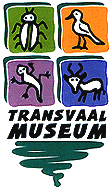
E - MAIL
Dr
Principal Researcher
Dr
Researcher
Preparator
Lawrence Radebe
Museum assistant
Palaeontology
The palaeontological collections include Plio-Pleistocene hominid fossils from the newly proclaimed Cradle of Humankind World Heritage Site, including the type specimen of Paranthropus robustus from Kromdraai, early Homo from Swartkrans, and the most complete cranium of Australopithecus africanus ("Mrs Ples") from Sterkfontein, and large collections of associated fauna with 33 type specimens.
Also housed at the Transvaal Museum are late Permian and early Triassic therapsids, amphibia, fishes, reptiles and plants from the Karoo, including 64 type specimens.
Other collections include fossil invertebrates, photographs and the Broom archives and CT (Computed Tomograhic) images.
|
PRICE LIST FOR FOSSIL CASTS (US Dollars) - 2005 click |
![]() The Millennium Sundial & A Walk through Time
The Millennium Sundial & A Walk through Time
A Millennium Sundial, engraved in granite, has been installed at the Sterkfontein Caves, a newly proclaimed World Heritage Site . The sundial project was announced at a function held at the Sterkfontein Heritage Lodge http://www.sterkfonteinlodge.com on March 22, 2001, associated with a "Walk through Time". This project serves to promote public awareness of the changing diversity of life within long periods of time, and has had financial support from the Ministry of Arts, Culture, Science and Technology.
|
|
![]() SK847: A Female robust australopithecine
SK847: A Female robust australopithecine
![]() A study of Chimpanzee skulls
A study of Chimpanzee skulls
Skulls of Chimpanzees have been measured in order to establish the probability of the development of a sagittal crest. The results are of interest in the context of Mrs. Ples.
![]() Late Pleistocene cave deposits in South Africa have yielded important hominid fossils and artefacts. This article concerns the dating of Late Pleistocene deposits associated with the "Howieson's Poort industry" from two cave sites in South Africa, with special reference to thorium and uranium analyses.Howieson's Poort
Late Pleistocene cave deposits in South Africa have yielded important hominid fossils and artefacts. This article concerns the dating of Late Pleistocene deposits associated with the "Howieson's Poort industry" from two cave sites in South Africa, with special reference to thorium and uranium analyses.Howieson's Poort
![]() Palaeo-environmental changes: The Transvaal Museum has for many years been undertaking work on past environmental changes that affected the distribution and abundance of many animals over long periods of time on the African continent. The effects of past climatic change on Robben Island have been examined in the context of past changes in sea level, associated with global changes in sea level. Of particular interest is the fact that about 10 000 years age, when sea levels were lower than they are today, there was a narrow land-bridge connecting Robben Island to the African mainland. Robben island in Xhosa.
Palaeo-environmental changes: The Transvaal Museum has for many years been undertaking work on past environmental changes that affected the distribution and abundance of many animals over long periods of time on the African continent. The effects of past climatic change on Robben Island have been examined in the context of past changes in sea level, associated with global changes in sea level. Of particular interest is the fact that about 10 000 years age, when sea levels were lower than they are today, there was a narrow land-bridge connecting Robben Island to the African mainland. Robben island in Xhosa.
![]() The genus Dinofelis represents a line of extinct cats often referred to as “false” saber-tooths
The genus Dinofelis represents a line of extinct cats often referred to as “false” saber-tooths
![]() "A study of organic residues in 17th century clay pipes suggests that
"A study of organic residues in 17th century clay pipes suggests that
tobacco was not the only substance smoked at Jan van Riebeeck's Fort and the
Castle, or in Shakespeare's home town of Stratford".
![]() Late Pleistocene and Holocene rock engravings have been discovered in sealed archaeological deposits dated to 77 000 and 10 000 years, from Blombos
Late Pleistocene and Holocene rock engravings have been discovered in sealed archaeological deposits dated to 77 000 and 10 000 years, from Blombos
and Wonderwerk Caves respectively. Geometric engravings may be associated with "entopic" imagery.
![]() Chemical analyses of organic residues from 17th clay pipes from Stratford-upon-Avon suggest the smoking of Cannabis and other compounds. The results of these forensic studies can be assessed in the context of literary evidence, including Shakespeare's references to a "noted weed", a "journey in my head" and the "Tenth Muse", possibly relating to the use of Cannabis associated with a "source of inspiration" ("invention", in the context of creative writing). These suggestions are based in part on the forensic analyses of clay pipes from Stratford-upon-Avon, and partly on a new assessment of Sonnet 76 and other texts Shakespeare.htm
Chemical analyses of organic residues from 17th clay pipes from Stratford-upon-Avon suggest the smoking of Cannabis and other compounds. The results of these forensic studies can be assessed in the context of literary evidence, including Shakespeare's references to a "noted weed", a "journey in my head" and the "Tenth Muse", possibly relating to the use of Cannabis associated with a "source of inspiration" ("invention", in the context of creative writing). These suggestions are based in part on the forensic analyses of clay pipes from Stratford-upon-Avon, and partly on a new assessment of Sonnet 76 and other texts Shakespeare.htm

